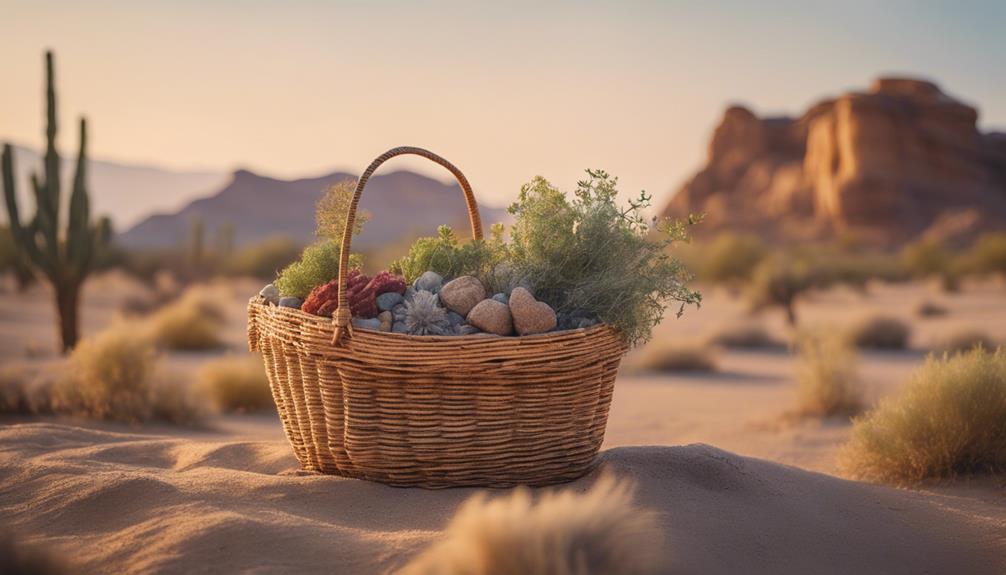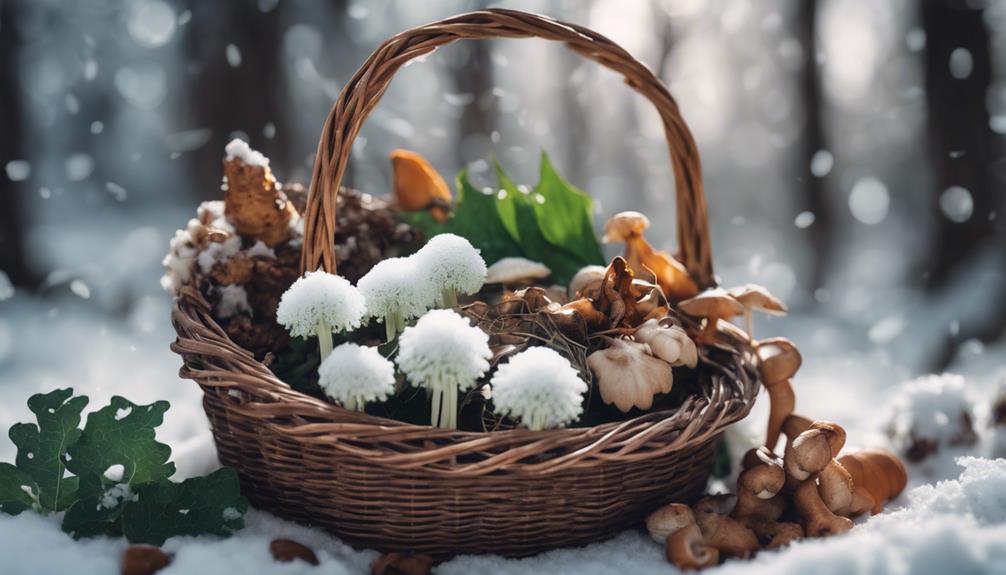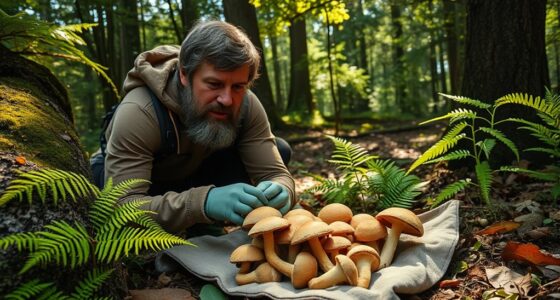You're about to discover the hidden treasures of Nevada's desert landscape, where an array of wild edibles await your discovery. From Mormon tea to mesquite pods, prickly pear cactus, Palo Verde beans, and jojoba, the desert offers a diverse range of flavors and textures. To get started, learn to identify and harvest plants sustainably, then experiment with cooking methods like grilling or roasting to bring out their unique flavors. As you continue, you'll uncover the secrets to preserving your harvest and crafting dishes that showcase Nevada's desert delights.
Key Takeaways
- Explore Nevada's desert landscape to discover diverse wild edibles like Mormon tea, mesquite pods, and prickly pear cactus.
- Identify and harvest plants sustainably to ensure a continued supply and respect the environment.
- Prioritize safety by staying hydrated, protecting from the sun, and respecting fire bans to prevent wildfires.
- Properly harvest and process wild finds to impact flavor and texture, and experiment with cooking methods for new flavors.
- Preserve the harvest through dehydration, freezing, or canning to enjoy Nevada's desert delights year-round.
Identifying Wild Edibles in Nevada
As you explore Nevada's desert landscape, you'll discover a diverse range of wild edibles waiting to be revealed, each with its unique characteristics and harvest seasons.
Among these edibles are Mormon tea, mesquite pods, prickly pear cactus, Palo Verde beans, and jojoba, each offering a distinct flavor and nutritional value.
In late summer, you can forage for mesquite pods, which are rich in protein, fiber, and minerals. Meanwhile, Palo Verde beans provide a valuable source of protein and fiber, making them an excellent food source for those looking to incorporate more plant-based options into their diet.
By understanding the unique characteristics of each plant, you can identify and harvest them sustainably, ensuring a continued supply of wild edibles in Nevada's desert landscape.
With knowledge of the local flora and their harvest seasons, you can reveal the desert's secrets and enjoy the rich flavors and nutritional benefits that Nevada's wild edibles have to offer.
Seasonal Foraging and Safety Tips

When foraging for wild edibles in Nevada's desert, you'll need to time your excursions according to the seasonal availability of each plant to maximize your harvest.
Some plants are perfect for eating raw, and I've eaten them straight from the desert floor. However, it's important to prioritize your safety while foraging. Nevada's desert climate can be unforgiving, so be sure to stay hydrated, protect yourself from the scorching sun, and take regular breaks in shaded areas.
Additionally, respect any fire bans in place, as dry desert conditions can spark devastating wildfires. When foraging, be mindful of potential hazards like thorns, spines, and wildlife. It's also vital to confirm proper identification of wild plants to avoid accidentally ingesting toxic or harmful species.
Harvesting and Processing Techniques

You'll find that properly harvesting and processing your wild desert finds is just as important as identifying and gathering them, as it can greatly impact their flavor, texture, and overall usability in your cooking.
When it comes to processing, you'll need to get creative. For instance, drying mesquite beans in the sun can help reveal their potential, turning them into a fine powder perfect for culinary use. Crushing them further reveals their sweet, nutty flavor and enhances their versatility in cooking.
Similarly, cooking prickly pear cactus pads in a steaming pit can tenderize them for consumption. Don't be afraid to experiment with different cooking methods for your gathered ingredients – you might stumble upon new flavors and textures!
Processing wild ingredients like jojoba seeds requires research and creativity to bring out their full potential. By mastering these harvesting and processing techniques, you'll be able to transform your desert finds into delicious, unique dishes that showcase the flavors of Nevada's desert landscape.
Cooking With Desert Delicacies

Now that you've mastered the art of harvesting and processing Nevada's wild desert ingredients, it's time to get creative in the kitchen and discover their unique flavors and textures.
Experiment with cooking methods like steaming, grilling, or roasting to bring out the best in your foraged finds.
Consider incorporating wild ingredients like mesquite powder or prickly pear cactus pads into traditional recipes for a unique twist.
You can even create entirely new dishes, such as mesquite porridge or prickly pear cactus salad, using the flavors and textures of the desert.
Don't be afraid to let the natural sweetness of mesquite powder or the tender texture of cooked prickly pear cactus pads shine through in your culinary creations.
Embrace the challenge of cooking with wild desert ingredients and get creative with your recipes.
With a little experimentation, you'll be enjoying delicious and innovative meals that showcase the best of Nevada's desert delights.
Experimenting With Flavor Profiles

How do you intend to balance the bold flavors of Nevada's desert delicacies to create a harmonious flavor profile that showcases their unique characteristics?
One approach is to experiment with combining flavors that complement each other. For instance, you can pair the earthy, nutty flavor of mesquite with the tartness of prickly pear cactus for a unique taste experience.
Alternatively, enhance your dishes by incorporating the rich, buttery flavor of Palo Verde beans with the mild, nutty taste of jojoba seeds.
When balancing flavors, consider the texture, color, and taste of each wild ingredient to create a harmonious and visually appealing dish.
You can also explore the potential of creating a savory and aromatic flavor profile by incorporating a mix of foraged ingredients like Mormon tea, mesquite, and Palo Verde beans.
Don't be afraid to think outside the box and try new combinations. By doing so, you'll reveal the full potential of Nevada's desert delicacies and create truly unforgettable dishes.
Presentation Matters: Desert Chic

As you start to plate your desert-foraged dishes, remember that the presentation is just as important as the flavors.
You'll want to create a visually appealing arrangement that echoes the desert landscape, incorporating elements like earthy tones, rustic textures, and natural accents.
Desert-Inspired Aesthetic
Incorporate earthy tones and natural textures into your table setting to transport your guests to the desert landscape. This will instantly evoke the feeling of being in the desert, surrounded by the rustic beauty of Nevada's wilderness.
To take your desert-inspired aesthetic to the next level, consider the following elements:
- Earthy tones: Incorporate sandy beige, burnt orange, and sage green into your table settings and decor to evoke the desert landscape.
- Natural materials: Use rustic, natural materials like woven baskets, wooden serving boards, and stone plates to enhance the desert-inspired aesthetic.
- Desert flora: Consider adding cactus or succulent plants as centerpieces or decor elements to bring a touch of the desert indoors.
Wild West Colors
You'll create an engaging presentation by incorporating the warm, earthy hues of the Wild West into your table setting, where the beauty of the desert landscape meets the flavors of foraged ingredients.
Desert chic is all about embracing earthy tones, rustic textures, and natural elements. Consider using desert-inspired tableware like clay plates, wooden utensils, and woven placemats to enhance the presentation. These elements will transport your guests to the desert landscape, setting the tone for a unique dining experience.
To add an extra layer of authenticity, garnish your dishes with edible desert flowers, cactus blossoms, or dried wild herbs. Arrange your foraged ingredients in a visually appealing manner, such as stacking prickly pear slices or drizzling mesquite powder for artistic flair.
Rustic Chic Accents
Bring the desert landscape to your table by incorporating rustic chic accents that evoke a sense of natural elegance. From the rough-hewn texture of wooden plates to the organic beauty of desert stones and dried plants, you'll create a cohesive and stylish look that celebrates the desert's unique charm.
To take your presentation to the next level, consider the following rustic chic accents:
- Earthy tones and textures: Incorporate wooden plates, woven baskets, or clay pottery to enhance the desert theme.
- Desert-inspired centerpieces: Use succulents or driftwood to create a minimalist yet stylish centerpiece.
- Natural garnishes: Experiment with edible flowers, dried herbs, or citrus zest to add a pop of color and elevate the visual appeal of your dish.
Preserving the Harvest for Later

Now that you've gathered a bounty of wild edibles, it's time to think about preserving them for later.
You'll want to explore different methods to keep your finds fresh and flavorful, from dehydration and freezing to canning and more.
Dehydrating Wild Delicacies
When foraging for wild delicacies like mesquite beans and jojoba seeds, dehydrating them helps lock in their unique flavors and nutrients, making them shelf-stable for later use. By removing the moisture from these ingredients, you can enjoy them year-round, even when they're out of season. Dehydrating is a simple and sustainable way to preserve the harvest, and it's easier than you think!
Here are three benefits of dehydrating wild delicacies:
- Longer shelf life: Dehydrated wild foods can be stored for months, allowing you to enjoy them throughout the year.
- Retains flavors and nutrients: Dehydrating helps preserve the intense flavors and nutrients of foraged ingredients, making them perfect for rehydrating and using in recipes.
- Versatile storage options: Dehydrated wild plants can be ground into powders or stored whole, giving you flexibility in how you use them in your cooking.
Freezing Fresh Finds
How do you guarantee that your freshly foraged finds remain fresh and flavorful for months to come? Freezing is a convenient way to preserve the harvest without losing nutrients or flavor.
Properly washing and drying wild plants before freezing helps maintain their quality and prevents freezer burn. Consider blanching certain wild ingredients like prickly pear cactus pads to retain texture and color.
Tips for Freezing Wild Foods:
- Wash and dry plants before freezing: Prevents freezer burn and maintains quality
- Blanch certain ingredients: Retains texture and color
- Use airtight containers or freezer bags: Prevents freezer burn and keeps food fresh
- Label containers with date of freezing: Easy tracking and organization
Frozen wild foods can be used in various dishes, allowing you to enjoy your foraged finds throughout the year.
Canning Season's Bounty
You can extend the shelf life of your foraged treasures by canning them, a tried-and-true method for preserving the harvest of wild foods like prickly pear cactus, mesquite pods, and jojoba seeds. By canning, you can enjoy the flavors of the desert throughout the year, even when the ingredients are out of season.
With proper canning techniques, you can maintain the freshness and flavor of your foraged ingredients, and they can be stored for long periods.
Here are just a few benefits of canning your wild food harvest:
- Year-round access: Canned wild foods can be stored for long periods, making them convenient for future use in cooking and culinary experiments.
- Preserved flavor: Canning helps maintain the flavor and freshness of your foraged ingredients, allowing you to savor the taste of the desert even in the off-season.
- Pantry staples: By canning the bounty of the desert, you can create a pantry stocked with homemade preserves from your foraging adventures, adding a unique touch to your culinary creations.
Frequently Asked Questions
How Do You Forage Wild Edibles?
You venture into the desert, armed with knowledge of seasonal plant availability and respect for fire bans. You identify edible species, harvest them sustainably, and process them creatively to reveal their culinary potential.
How Do Beginners Do Forage?
You start foraging by researching local plants, learning about edible parts and seasonal availability. Then, you familiarize yourself with local laws, join foraging groups, and positively identify plants before harvesting to guarantee a safe and enjoyable experience.
What Are the Wild Edible Plants in Nevada?
You'll find a variety of wild edibles in Nevada, including Mormon tea, mesquite pods, prickly pear cactus, Palo Verde beans, and jojoba, each offering unique flavors and nutritional benefits when foraged and cooked correctly.
What Should You Avoid When Foraging?
'When you venture out to forage, beware – you're not just searching for food, you're playing with fire. Avoid contaminated areas, toxic look-alikes, protected species, trespassing, and over-harvesting to guarantee your safety and the ecosystem's survival.'
Conclusion
As you venture into Nevada's desert landscape, remember to 'bite off what you can chew' and respect the land and its wild edibles. The arid environment may appear barren at first glance, but it hosts a surprising variety of plants, such as prickly pear cactus and wild onions, that have sustained people for centuries. Just as with foraging in California, always ensure you can correctly identify the plants you encounter to avoid any harmful varieties. Additionally, be mindful of state regulations and gather responsibly to maintain the delicate balance of this unique ecosystem.
By following these guidelines, you'll be well on your way to foraging like a pro.
Happy hunting, and don't get too 'prickly' about trying new things – you never know what desert delights you might discover!










